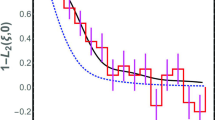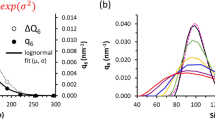Abstract
Caused by the interaction between the particles, structural fluctuations influence thermodynamics and order of transformation of an ensemble of nanoparticles. A stringed thermodynamic analysis revealed that, in fluctuating ensembles, the ratio of particle numbers in the equilibrium over the one in the non-equilibrium phase is independent of any metastable in between. Structural transformations in such ensembles, connected to latent heat, are of infinite order. These findings are summarized in a set of theorems ruling structural fluctuations. Finally, the consequences of fluctuations are demonstrated by an example.





Similar content being viewed by others
References
Ajayan PM, Marks LD (1988) Quasimelting of small particles. Phys Rev Lett 60:585–587
Ascencio JA, Perez-Alvarez M, Tehuacanero S, Jose-Yacaman M (2001) Experimental and theoretical studies of instabilities of metal nanoparticles: a new kind of quasimelting. Appl Phys A 73:295–300
Ascencio JA, Mendoza M, Santamaria T, Perez M, Nava I, Gutierrez-Wing C, Jose-Yacaman M (2002) Structural instabilities in passivated gold nanoclusters induced by electron irradiation. J Clust Sci 13:189–197
Balibar S, Gallet F, Graner F, Rolley E (1990) Crystalline surfaces in Helium. Physica A 163:111–124
Berry S (1998) Size is not everything. Nature 393:212–213
Bondarchuk O, Dougherty DB, Degawa M, Williams ED, Constantin M, Dasgupta C, Das Sarma S (2005) Correlation time for step structural fluctuations. Phys Rev B 71:045426-1–045426-10
Bustamante C, Liphardt J, Ritort F (2005) The nonequilibrium thermodynamics of small systems. Phys Today 58:43–48
Callen HB (1985) Thermodynamics and an introduction to statistics. Wiley, New York
Castro T, Reifenberger R, Choi E, Andres RP (1990) Size-dependent melting temperature of individual nanometer sized metallic clusters. Phys Rev B 42:8548–8556
Chang J, Johnson E (2005) Surface and bulk melting of small metal clusters. Philos Magn 85:3617–3627
CRC Handbook of Chemistry and Physics (2006–2007) Taylor & Francis, Boca Raton
Crooks GE (1999) Entropy production fluctuation theorem and the nonequilibrium work relation for free energy differences. Phys Rev E 60:2721–2726
Dick K, Dhanasekaran T, Zhang Z, Meisel DJ (2002) Size dependent melting of silica-encapsulated gold nanoparticles. Am Chem Soc 124:2312–2317
Hendy SC (2005) Stability and phase coexistence in atomic clusters. Phys Rev B 71:115404-1–115404-5
Iijima S, Ichihashi T (1986) Structural instability of ultrafine particles of metals. Phys Rev Lett 56:616–619
Jaeger G (1998) The Ehrenfest classification of phase transitions: introduction and evolution. Arch Hist Exact Sci 53:51–81
Jarcynski C (1997) Nonequilibrium equality for free energy differences. Phys Rev Lett 78:2690–2693
Lee JG, Mori H (2004) Solid/liquid two-phase structures in isolated nanometer-sized alloy particles. Phys Rev B 70:144105-1–144105-5
Meschede D (2006) Gehrtsen physik, 22th edn. Springer, Berlin, pp 255 ff
Miedema AR, Boom R (1978) Surface tension and electron density of pure liquid metals. Z Metallkde 69:183–190
Miedema AR (1978) Surface energy of solid metals. Z Metallkde 69:287–292
Nanda KK, Maisels A, Kruis FE, Fissan H, Stappert S (2003) Higher surface energy of free nanoparticles. Phys Rev Lett 91:106102-1–106102-4
Oshima Y, Takayanagi K (1993) Solid liquid phase transition of tin particles observed by UHV high resolution transmission electron microscopy: pseudo crystalline phase. Z Phys D 27:287–294
Proykova A, Berry RS (1997) Analogues in clusters of second-order transitions. Z Phys D 40:215–220
Schmidt M, Kusche R, von Issendorf B, Haberland H (1998) Irregular variations in the melting point of size selected atomic clusters. Nature 393:238–240
Shirinyan AS, Wautelet M (2004) Phase separation in nanoparticles. Nanotechnology 15:1720–1731
Vollath D (2008) Nanomaterials, WILEY-VCH, Weinheim
Vollath D, Fischer FD, Hagelstein M, Szabo DV (2006) Phases and phase transformations in nanocrystalline ZrO2. J Nanopart Res 8:1003–1016
Vollath D, Wedemeyer H (1990) Aluminium doped lithium orthosilicate as a breeder material. Adv Ceram 27:3–12
Vollath D, Fischer FD (2008) Structural fluctuations in nanoparticles. J Nanopart Res. doi:10.1007/s11051-007-9326-3
Wang YD, Ren Y, Nie ZH, Liu DM, Zuo L, Choo H, Li H, Liaw PK, Yan JQ, McQueeney RJ, Richardson JW, Huq A (2007) Structural transition of ferromagnetic Ni2MnGa nanoparticles. J Appl Phys 101:063530-6
Acknowledgements
F. D. Fischer expresses his thanks to Dr. E. R. Oberaigner, Leoben, for valuable discussions and provision of some comparison calculations with MAPLE (www.maplesoft.com).
Author information
Authors and Affiliations
Corresponding author
Appendix
Appendix
Derivatives of the free enthalpy with respect to temperature
We consider derivatives of a class of functions f i (c i ,c 2) with respect to δ and calculate their derivatives \( \partial ^p {{f_i } \mathord{\left/ {\vphantom {{f_i } {\partial \delta }}} \right. \kern-\nulldelimiterspace} {\partial \delta }}^p \) for 0 < p and \( \delta \Rightarrow 0 \). The first function to be investigated is
with
The quantities T c corresponds to T cross and R to kM/m in the main body of this paper. Note that the fractions c 1, c 2 are related by \( c_2 = 1 - c_1 \), and c 1, c 2 are 1/2 for δ = 0. The first derivative follows as \( \left. {{{\partial f_1 } \mathord{\left/ {\vphantom {{\partial f_1 } {\partial \delta }}} \right. \kern-\nulldelimiterspace} {\partial \delta }}} \right|_{\delta = 0} = {{ - \left( {s_1 + s_2 } \right)} \mathord{\left/ {\vphantom {{ - \left( {s_1 + s_2 } \right)} 2}} \right. \kern-\nulldelimiterspace} 2} \) and is symmetric with respect to s 1 and s 2.
The Leibniz rule allows immediately to write with \( \delta \Rightarrow 0 \)
Therefore, the problem is reduced to the derivatives of c 1 with respect to δ. Since c 1 can be formulated as a function \( c_1 \left( {\phi \left( \delta \right)} \right) \), see (A2), the chain rule makes it necessary to have the derivatives
The quantities A n are premultipliers independent of s 1 and s 2.
Calculating \( {{\partial ^p c_1 } \mathord{\left/ {\vphantom {{\partial ^p c_1 } {\partial \delta ^p }}} \right. \kern-\nulldelimiterspace} {\partial \delta ^p }} \) yields p terms. Each term is the product of the nth derivative (A4), n = 1,…p, with an expression being the product of two derivatives (A5), so that this expression is always proportional to (s 2 − s 1)n. Since only the uneven terms (n=1, 3,…) survive due to (A4), we find that according to (A3), the pth derivative \( {{\partial ^p f_1 } \mathord{\left/ {\vphantom {{\partial ^p f_1 } {\partial \delta ^p }}} \right. \kern-\nulldelimiterspace} {\partial \delta ^p }} \) is a series of \( \left( {\left[ {{p \mathord{\left/ {\vphantom {p 2}} \right. \kern-\nulldelimiterspace} 2}} \right] + 1} \right) \) terms of even powers of (s 2 − s 1). This means finally that the pth derivative of f 1 is symmetric with respect to s 1 and s 2. In order to verify successfully verify such an expression, the symbolic processor MAPLE (www.maple.com) has been employed.The next function to be investigated is
The first derivative is
and antimetric in s 1 and s 2. According to the Leibniz rule \( {{\partial ^p f_2 } \mathord{\left/ {\vphantom {{\partial ^p f_2 } {\partial \delta ^p }}} \right. \kern-\nulldelimiterspace} {\partial \delta ^p }},p > 1 \), consists of (p + 1) terms being products of \( {{\partial ^{p - \ell } c{}_1} \mathord{\left/ {\vphantom {{\partial ^{p - \ell } c{}_1} {\partial \delta ^{p - \ell } }}} \right. \kern-\nulldelimiterspace} {\partial \delta ^{p - \ell } }} \) and the \( \ell - th \) derivative of \( \ell nc_1 \). As we have shown above for f 1, the first multiplier is always an uneven function in powers of (s 2 − s 1) for \( p - \ell \ge 2 \), and therefore, is asymmetric in s 1 and s 2. The second multiplier is a sum of \( \ell \) terms, which can be even or uneven in powers of (s 2 − s 1). Finally, a series of even or uneven powers of (s 2 − s 1) remains for \( {{\partial ^p f_2 } \mathord{\left/ {\vphantom {{\partial ^p f_2 } {\partial \delta ^p }}} \right. \kern-\nulldelimiterspace} {\partial \delta ^p }} \) at δ = 0.
As last case, we consider
In analogy of the treatment of f 2, the even powers of (s 2 − s 1) in \( {{\partial ^p f_3 } \mathord{\left/ {\vphantom {{\partial ^p f_3 } {\partial \delta ^p }}} \right. \kern-\nulldelimiterspace} {\partial \delta ^p }},p > 1 \), have the same sign as in \( {{\partial ^p f_2 } \mathord{\left/ {\vphantom {{\partial ^p f_2 } {\partial \delta ^p }}} \right. \kern-\nulldelimiterspace} {\partial \delta ^p }},\delta = 0,p > 1 \) and for δ=0 also the same coefficients, since \( c_1 = c_2 = {1 \mathord{\left/ {\vphantom {1 2}} \right. \kern-\nulldelimiterspace} 2} \). However, the first multipliers \( {{\partial ^{p - \ell } c_2 } \mathord{\left/ {\vphantom {{\partial ^{p - \ell } c_2 } {\partial \delta ^{p - \ell } }}} \right. \kern-\nulldelimiterspace} {\partial \delta ^{p - \ell } }} \) are always uneven and are \( {{ - \partial ^{p - \ell } c_1 } \mathord{\left/ {\vphantom {{ - \partial ^{p - \ell } c_1 } {\partial \delta ^{p - \ell } }}} \right. \kern-\nulldelimiterspace} {\partial \delta ^{p - \ell } }} \). This means that the uneven powers of (s 2 − s 1) in \( {{\partial ^p f_3 } \mathord{\left/ {\vphantom {{\partial ^p f_3 } {\partial \delta ^p }}} \right. \kern-\nulldelimiterspace} {\partial \delta ^p }},\delta = 0 \), have coefficients with the same value as in \( {{\partial ^p f_2 } \mathord{\left/ {\vphantom {{\partial ^p f_2 } {\partial \delta ^p }}} \right. \kern-\nulldelimiterspace} {\partial \delta ^p }} \), δ = 0, however, with a negative sign.
The conclusion is that \( \partial ^p {{\left( {f_2 + f_3 } \right)} \mathord{\left/ {\vphantom {{\left( {f_2 + f_3 } \right)} {\partial \delta ^p }}} \right. \kern-\nulldelimiterspace} {\partial \delta ^p }} = 0 \), δ = 0, only have even powers of (s 2 − s 1). This has also been verified by using MAPLE (http://www.maple.com) up to a high order of the derivative.
Rights and permissions
About this article
Cite this article
Vollath, D., Fischer, F.D. Structural fluctuations in ensembles of nanoparticles. J Nanopart Res 11, 647–654 (2009). https://doi.org/10.1007/s11051-008-9413-0
Received:
Accepted:
Published:
Issue Date:
DOI: https://doi.org/10.1007/s11051-008-9413-0




